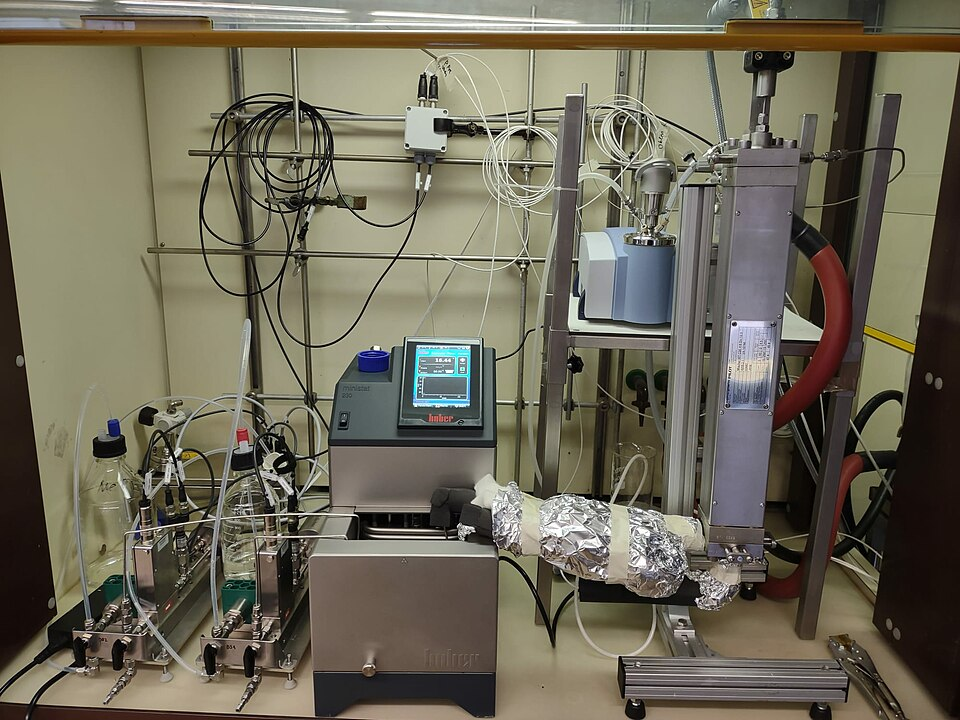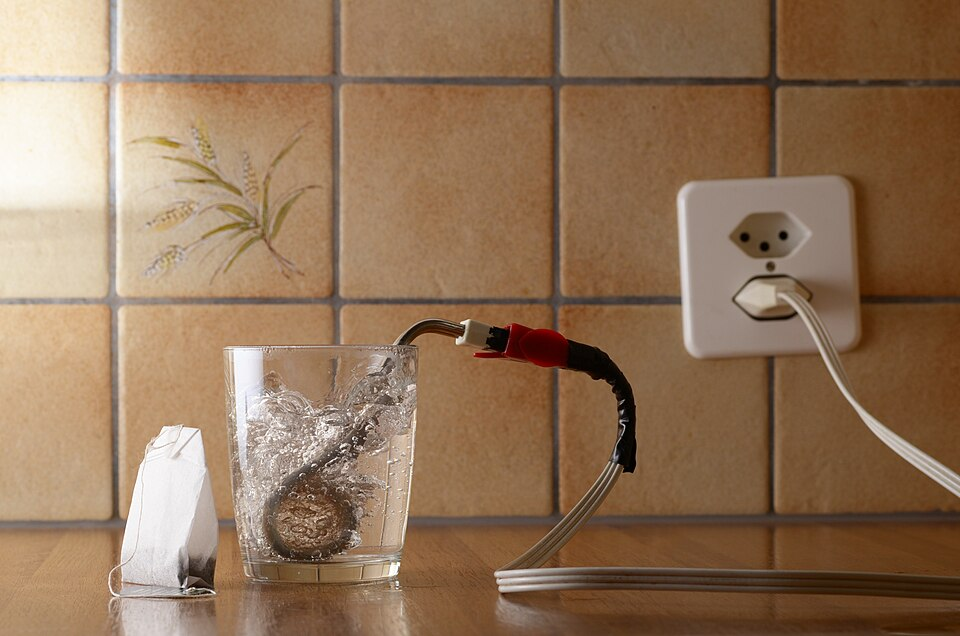OCR Specification focus:
‘Use appropriate techniques to measure latent heat for a solid and a liquid precisely.’
Precise measurement of specific latent heat for solids and liquids requires careful experimental technique, minimising heat losses, and applying electrical heating methods with accurate instrumentation and control.
Understanding Latent Heat
When a substance changes phase, such as melting or vaporisation, energy is absorbed or released without a change in temperature. This energy is the latent heat. For accurate experimental determination, students must focus on both measurement accuracy and energy transfer efficiency.
Specific Latent Heat: The amount of energy required to change the phase of 1 kilogram of a substance without a temperature change.
This quantity depends on the substance and whether the process is fusion (solid to liquid) or vaporisation (liquid to gas).
Measuring Latent Heat of Fusion (Solids)
To measure the specific latent heat of fusion, students commonly use ice as the sample solid. The experiment determines the energy required to melt the ice using an electrical heating system.
Essential Apparatus
Electrical heater with known power rating
Insulated container or calorimeter
Ammeter and voltmeter
Stopwatch or timer
Thermometer or temperature probe
Balance for accurate mass measurement
Experimental Setup and Method
Prepare the sample: Use small pieces of pure ice dried of surface water to ensure no pre-existing melt affects results.
Assemble apparatus: Place ice in the calorimeter equipped with an electrical heater and temperature sensor.
Start measurements: Record voltage (V), current (I), and time (t) as the ice melts completely.
Measure mass: Determine the mass of melted water (m) using the balance.
Calculate energy supplied:
Use the electrical relationship E = VIt to find the energy transferred from the heater to the system.
Compute latent heat: Divide the energy by the mass of melted ice.
EQUATION
—-----------------------------------------------------------------
Specific Latent Heat of Fusion (L) = E / m
E = energy supplied by the heater (joules, J)
m = mass of substance melted (kilograms, kg)
—-----------------------------------------------------------------
This equation quantifies the energy absorbed per kilogram during the phase change.
Reducing Experimental Errors
Minimise heat losses: Use insulation and limit air exposure.
Avoid superheating or premature melting: Start measurements when the ice is at 0°C.
Ensure full melting: Confirm the sample changes phase completely before measurement ends.
Calibrate instruments: Accurate voltmeter and ammeter readings are essential for valid results.
Use an insulated container or calorimeter with a lid and thermometer to reduce heat exchange with the surroundings when working with solids.

A laboratory calorimeter used to limit heat exchange with the environment during measurements on solids. The arrangement illustrates the principle of thermal insulation that underpins reliable latent-heat work. This example includes a pre-heater module, which exceeds the syllabus requirement but does not alter the core technique. Source.
Measuring Latent Heat of Vaporisation (Liquids)
The specific latent heat of vaporisation is determined by measuring the energy required to convert a known mass of liquid, such as water, into vapour at its boiling point.
Apparatus
Electrical heater or immersion heater
Beaker or boiling tube containing the liquid
Condenser or collection vessel
Ammeter, voltmeter, and timer
Balance for mass loss measurement
Procedure
Heat the liquid to its boiling point and maintain a steady boil.
Record electrical values for voltage and current, along with the heating duration.
Measure mass change: Determine the reduction in mass as vapour escapes, representing the evaporated mass (m).
Calculate energy supplied using E = VIt.
Determine specific latent heat by dividing energy by mass.
Use an immersion heater with a known electrical power and measure the current and potential difference to calculate the energy input, E=VItE = VI tE=VIt.

Immersion heater used to deliver a controlled electrical energy input to a liquid. In practice, the current and potential difference are recorded to determine E=VItE = VI tE=VIt while mass loss or phase change is monitored. The image focuses on the heater element itself, which is all that is required by the technique. Source.
EQUATION
—-----------------------------------------------------------------
Specific Latent Heat of Vaporisation (L) = E / m
E = energy supplied by the heater (joules, J)
m = mass of liquid evaporated (kilograms, kg)
—-----------------------------------------------------------------
Between heating and measurement, there must be careful control to prevent underestimation of energy loss due to radiation or convection.
Precision Techniques and Considerations
1. Minimising Heat Loss
Use insulating materials around the container to reduce thermal transfer to surroundings.
Conduct the experiment in a draft-free environment to prevent convection losses.
Keep temperature sensors immersed appropriately for reliable readings.
2. Ensuring Accurate Electrical Energy Input
Measure voltage and current simultaneously to account for any variation in heater performance.
Avoid resistance fluctuations in wires by ensuring connections are tight and the heater is clean.
3. Calibration and Instrument Sensitivity
Use digital meters with suitable resolution and precision (e.g., 0.01 A, 0.01 V).
Calibrate the balance before weighing substances.
Use a timer with a clear display and start/stop at the same reference point to avoid timing bias.
4. Controlling Temperature
For solids: Ensure sample starts at the correct melting point temperature.
For liquids: Maintain constant boiling temperature throughout measurement to ensure steady energy transfer.
Record steady-state readings to minimise transient effects.
Sources of Uncertainty and Error Analysis
Heat absorbed by apparatus: Some energy heats the container instead of causing phase change.
Incomplete phase change: Not all material may melt or vaporise, leading to inaccurate mass readings.
Evaporation before heating: Mass loss before reaching boiling point introduces systematic error.
Electrical measurement error: Inaccurate readings of current or voltage affect total energy calculations.
Mitigation involves performing control experiments, repeating measurements, and averaging results to improve reliability.
Best Practices for Precision
Record all data in a table with consistent units.
Repeat the experiment to identify anomalous data and compute mean values.
Report uncertainties in all quantities, e.g., ±0.01 A or ±0.1 g.
Apply corrections for heat losses using calibration or by extrapolation to zero heat loss when possible.
By combining careful technique, accurate measurements, and awareness of potential errors, students can achieve precise and valid determinations of specific latent heats for both solids and liquids.
FAQ
The key difference lies in controlling the phase change environment. For solids (fusion), the focus is on melting at a fixed temperature, requiring insulation and careful temperature monitoring to prevent premature melting.
For liquids (vaporisation), the process must occur at constant boiling temperature, with the rate of vaporisation maintained steady and the mass loss of vapour measured precisely. Heat loss is usually greater for liquids, so additional insulation and environmental control are essential.
Impurities alter the phase change temperature and can introduce mixed-phase behaviour over a temperature range instead of a single, sharp transition.
This means that energy supplied may partly raise temperature rather than solely drive the phase change.
Using pure substances ensures a well-defined melting or boiling point, improving accuracy in the measurement of specific latent heat.
Corrections are often made by performing a calibration experiment using a known substance or by extrapolating data to the point where heat losses are theoretically zero.
Alternatively, energy loss can be estimated by repeating the experiment under different insulation conditions and comparing results. This allows the experimenter to determine a systematic offset that can be subtracted from the total electrical energy supplied.
If heating is too rapid, temperature gradients develop within the material or liquid, leading to uneven phase change and inaccurate measurements of when the process completes.
A slower heating rate ensures the system remains close to thermal equilibrium, so the measured energy more closely represents the true energy required for the phase change.
Maintaining steady, controlled heating improves reproducibility and reduces uncertainty in results.
Digital temperature probes, data loggers, and digital balances reduce reading errors and allow continuous monitoring of key variables.
They eliminate parallax error and allow more precise detection of stable temperatures or small mass changes.
Additionally, digital data recording helps identify fluctuations in current, voltage, or temperature that might indicate heat loss or incomplete phase change, improving the reliability of the measured latent heat value.
Practice Questions
Question 1 (2 marks)
Describe one method used to reduce heat loss when determining the specific latent heat of fusion for ice in a laboratory experiment.
Mark scheme:
1 mark for identifying a valid method of reducing heat loss (e.g., using an insulated calorimeter or foam cup).
1 mark for explaining how this method reduces energy transfer (e.g., it minimises energy loss to the surroundings, ensuring more accurate energy measurement for melting).
Question 2 (5 marks)
A student is determining the specific latent heat of vaporisation of water using an electrical heater. The current through the heater is 2.0 A, and the potential difference across it is 12.0 V. The heater is switched on for 300 s. During this time, 0.080 kg of water is converted to steam at its boiling point.
(a) Calculate the specific latent heat of vaporisation of water based on these results.
(b) Suggest and explain two sources of error that could lead to an overestimation or underestimation of the value obtained.
Mark scheme:
(a) (3 marks total)
1 mark for correctly identifying or stating the equation: L = E / m or E = V I t.
1 mark for correctly calculating energy: E = 12.0 × 2.0 × 300 = 7200 J.
1 mark for correct final value: L = 7200 / 0.080 = 9.0 × 10⁴ J kg⁻¹ (allow range 8.9–9.1 × 10⁴ J kg⁻¹).
(b) (2 marks total)
1 mark for identifying each valid source of error (e.g., heat loss to surroundings, evaporation before heating, inaccurate mass measurement).
1 mark for explaining the effect on the result (e.g., heat loss causes an underestimation of latent heat, as not all supplied energy goes into vaporising the water).

